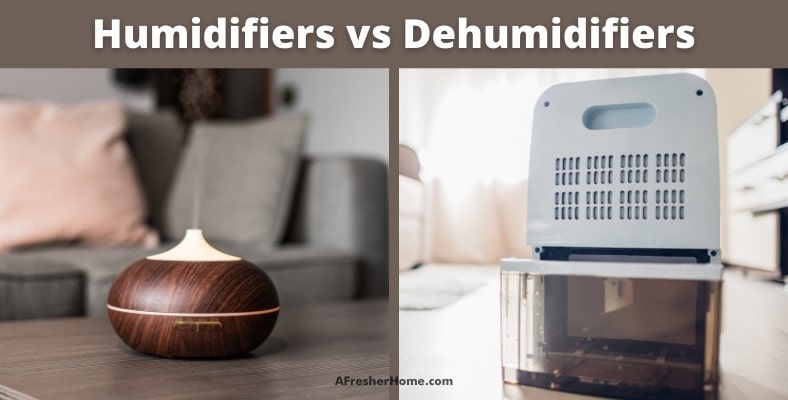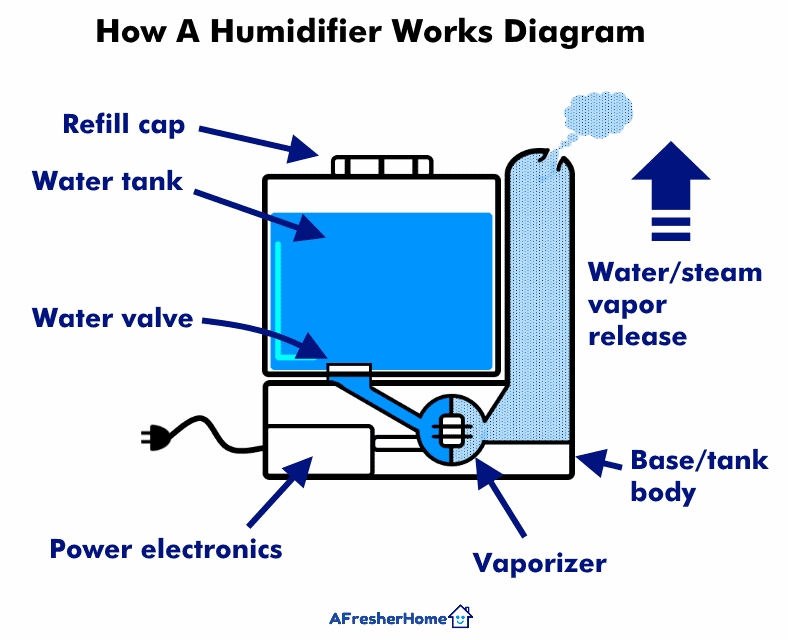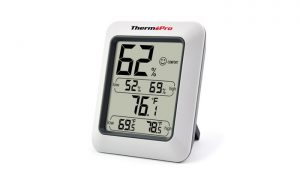Dryness, moisture, humidity, “relative humidity”…what does it all mean? And how do you know for sure when using a humidfier can help?
In this article, I’ll explain exactly how to know if you need a humidifier – and a lot more helpful info, too!
Contents
Signs You Need a Humidifier
Consistent Congestion
Although it’s normal to experience congestion when you have a cold or a similar sickness bug, if you’re frequently waking up feeling congested and becoming bunged up again at night, it’s likely a sign that the humidity in your room is low.
This is because your AC or the climate in certain seasons dries out the air you breathe. Dry air in winter or dry climates has a very low amount of humidity (often below 25%) which causes your nasal passages to dry out.
It’s especially bad for asthma sufferers as the dryness of the air can also exaggerate any existing symptoms.
Dry Skin and Dry Lips
Another side effect of dry air is persistently dry skin and cracked lips. It’s usually a sign that there’s not enough moisture in the air.
No amount of expensive oils or moisturizers will be as effective as investing in a humidifier for your bedroom if you’re suffering from dry skin due to low humidity.
Nosebleeds
Spending time in an environment where the air is particularly dry can dry out your nasal membranes, making them more susceptible to bleeding, irritation, and sneezing, and sickness.
While it’s true that there are a number of reasons a nosebleed can happen if you don’t typically suffer from them and you suddenly start having random bleeding from your nose it’s often due to dry air. In those cases, you’ll need to restore a healthy moisture level to restore the mucous membranes and comfort in your nose and sinuses.
You’ll also relieve dry eyes in that case, too, so it’s not just a solution for your nose.
Dry Cough
Being kept awake at night with a persistent cough is another sign of excessively dry air. It’s a somewhat common symptom of using air conditioning units or especially heaters in your home.
They’re notorious for drying out the air and your throat at the same time which results in an unpleasant cough. If dust or other irritants are present around you that can trigger a cough, they’re more freely able to move when the air is extremely dry much like allergens.
Allergy symptoms
Allergies can of course be present in healthy humidity levels but the problem is that dust mites, pet dander, and a variety of other allergens will affect you even more when the humidity is too low.
Allergy sufferers often need a humidifier to bring the air back to a healthy level, decreasing the effects of allergens on the body.
How Do I Know If I Need a Humidifier or Dehumidifier?
Humidifiers and dehumidifiers can make a huge difference in the quality of your life & home comfort, but what are the main differences and why does it matter?
What is the Difference Between Humidifiers and Dehumidifiers?
To put it simply:
- A humidifier adds moisture to the air in an environment when the humidity is too dry.
- A dehumidifier does the opposite and removes moisture from the air when it becomes too humid.
Both can be used to control seasonal allergies and to ensure a comfortable environment where the humidity level isn’t too low or too high. They both can be helpful for some home-related concerns, too, as you’ll see.
How does a humidifier work?
A humidifier adds moisture to the air by changing liquid water into a fine mist that is released into the air.
The most common, and most effective, models use power from a standard electrical outlet to run. You can also find others that are evaporative, meaning they simply let the water slowly evaporate to do the same thing (although much less quickly).
The power electronics inside use electrical power to drive a vaporizer element. The vaporizer changes the liquid form of water into a fine mist that rises through an exit passageway and out a nozzle into the room’s air.
A vaporizer is most often one of a few types:
- Thermal (heating element)
- Ultrasonic
- Electro-mechanical
There are two main types of electrical humidifiers:
- Thermal (warm mist)
- Ultrasonic (cool mist)
Both have pros and cons but cool mist models can work anywhere regardless of the temperature.
How does a dehumidifier work?
Dehumidifiers are powered by electricity and use a refrigerant, circulated by a compressor under pressure, to pull humid air across a low-temperature assembly that condenses moisture into water. The water is then collected in a tank for emptying once full.
In fact, dehumidifiers use a refrigerant system extremely similar to those of home air conditioning units or refrigerators. The difference is that they blow warm, dry air into the outlet instead of cold air like home AC units.
An electric motor, controlled by electronics, powers the compressor when the detected room humidity goes above a level set by the user. To do this, many dehumidifiers provide a display panel and control buttons to adjust the acceptable humidity level before the system starts again.
Signs You Need a Dehumidifier
The majority of homes have a natural humidity level of between 30 percent and 50 percent; a humidity level above 50-55% or so means that you need a dehumidifier. As a general rule, anything lower than 30 percent will require a humidifier.
To check whether or not you need a dehumidifier, look out for the following signs or test the humidity level in your home using a digital temperature and humidity gauge.
Example of a digital temperature and humidity gauge. These make it easy to know for sure the humidity in your home.
Mold Spots or Damp
Enclosed spaces that are exposed to higher humidity levels are often prone to mold growth which shows up in the forms of mold spots or patches of dampness on the walls or ceiling.
These are pretty big red flags that signal that the humidity in your home (commonly in the basement) is too high. A dehumidifier can help to reduce the humidity which slows down this growth and keep it under 60% more, discouraging the growth of mold or mildew.
Peeling Paint or Wallpaper
Environments with more than 50% humidity contain more moisture in the air than spaces with low humidity. This can lead to a build up of moisture that results in damage to areas of your home including surface damage to your walls.
If the wallpaper or paint is starting to peel away from the wall in places, it’s sometimes a sign that there’s too much moisture in the room.
Worsening Allergies or Asthma
Mold spores that can linger in the air as a result of excessive humidity and the bacterial growth it promotes can have a serious effect on anyone suffering from allergies or health conditions like asthma.
If you notice your symptoms getting worse, especially when you’re spending large periods of time at home, it may be a sign that you need a dehumidifier.
However, if you try using one for a while and don’t notice any difference, it’s worth contacting your doctor and checking your home for other causes.
What is a good humidity level?
Just in case you weren’t aware, it’s important to know that temperature affects how much moisture the air can “hold.” It’s normally expressed as a percentage. The higher the temperature, the more humidity that’s possible.
As a general rule, 50% humidity is right for nearly everyone and is a good target. When the humidity is lower than 30 percent that means that your home is too dry and you need a humidifier.
Note that these are general suggestions. You don’t have to get it perfectly matched to one particular number, just close.








